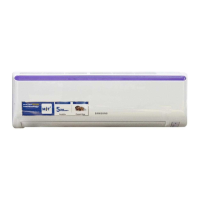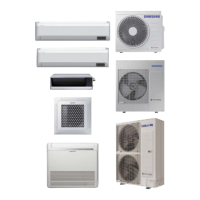Do you have a question about the Samsung AR7000 and is the answer not in the manual?
Explains how the 2-step cooling function quickly cools the room and adjusts fan speed.
Describes the Fast function for strong and powerful cooling or heating.
Details the Comfort function for gentle, indirect cooling or heating for comfort.
Covers the Single User function to minimize energy consumption when alone.
Explains the easy filter removal and cleaning process for better air quality.
Details the good'sleep function for achieving deep, comfortable night's sleep.
Describes the Smart Install feature that checks installation completion.
Highlights the straightforward process of hanging the unit on the wall.
Explains important safety symbols (Warning, Caution) and their meanings.
Details precautions for power line connection, extension cords, and grounding.
Stresses that installation must be performed by a qualified technician.
Covers installing an isolation switch and ensuring proper grounding.
Discusses selecting safe locations, avoiding hazards like gas leaks.
Emphasizes correct drain hose installation to prevent water leakage.
Outlines safe practices for handling power wiring, avoiding damage.
Advises cutting power during thunderstorms or long periods of non-use.
Details actions for flooded appliances or those emitting strange smells/smoke.
Provides guidance on actions to take in case of a gas leak.
Advises contacting service for reinstallation and notes potential charges.
Warns against touching circuit breakers with wet hands and airflow blades.
Highlights dangers to children, including packaging materials and unit access.
Advises on ventilation in poorly ventilated areas to prevent oxygen deficiency.
Instructs to cut power if foreign substances like water enter the appliance.
Warns against self-repair, modification, and using incorrect fuses.
Advises against placing objects on the unit and operating with wet hands.
Warns against spraying chemicals and drinking unit water.
Advises against strong impacts on the remote and touching pipes.
Warns against unusual uses and exposing living things to airflow.
Addresses child supervision and use by individuals with reduced capabilities.
Details safety measures for cleaning, including power cutoff.
Provides a table of temperature and humidity ranges for efficient operation.
Explains internal protections like 'Defrost cycle' and 'Protect compressor'.
Mentions the Smart Install function for checking installation completion.
Identifies and illustrates the main components of the air conditioner's indoor unit.
Shows and explains the indicators on the indoor unit display.
Details the functions of each button on the remote controller.
Explains the various indicators and symbols shown on the remote controller display.
Describes the low battery indicator and how to replace batteries.
Guides on storing the remote controller and inserting batteries.
Explains the automatic mode and the 2-step cooling process.
Details the operation and features of the Cool mode.
Describes the Dry mode for dehumidification and its usage.
Explains the Fan mode for air circulation.
Covers the operation and features of the Heat mode.
Illustrates how to select operating modes using the Mode button.
Explains how to adjust the desired temperature using the Temp buttons.
Details how to set the fan speed for different modes.
Explains how to adjust vertical airflow using the remote controller.
Details how to adjust horizontal airflow using the remote controller.
Guides on how to set the timer for the air conditioner to turn on.
Explains how to cancel the set On timer.
Lists additional settings like Mode and Temp for the On timer.
Details how to set the timer for the air conditioner to turn off.
Describes how to cancel the set Off timer.
Explains how On and Off timers can be used together.
Guides on setting the good'sleep mode for comfortable sleep.
Explains how to cancel the good'sleep mode setting.
Lists options like temperature adjustment for good'sleep mode.
Details how temperature and fan speed change during sleep stages.
Explains the steps to activate the 2-Step Cooling function.
Describes how to cancel the 2-Step Cooling function.
Guides on activating the Fast function for powerful cooling/heating.
Explains how to cancel the Fast function.
Details how to activate the Comfort function for mild cooling/heating.
Describes how to cancel the Comfort function.
Explains how to activate the Single User function for energy saving.
Describes how to cancel the Single User function.
Lists options like temperature and fan speed adjustments for Single User mode.
Guides on activating the Quiet function to reduce noise.
Explains how to cancel the Quiet function.
Lists options like temperature and fan speed for Quiet mode.
Explains how to activate the Auto Clean function for clean air.
Describes how to cancel the Auto Clean function.
Guides on how to mute the beep sound from the indoor unit.
Explains how to display and check the electricity consumed by the air conditioner.
Guides on resetting the filter clean reminder after cleaning the filter.
Explains how to adjust or turn off the display lighting.
Guides on setting up the WiFi function for smart control.
Explains how to set up the WPS function for wireless connection.
Provides instructions and precautions for cleaning the indoor unit.
Details how to clean the outdoor unit's heat exchanger.
Explains how to remove the air filter from the indoor unit.
Provides steps for cleaning the air filter.
Guides on how to reinstall the air filter after cleaning.
Presents a chart of periodic maintenance checks for the air conditioner.
Lists solutions for when the air conditioner is not functioning.
Provides solutions for issues with temperature adjustment.
Offers solutions for problems with air output.
Details troubleshooting steps for airflow issues.
Solutions for when fan speed cannot be adjusted.
Troubleshooting tips for a non-functional remote controller.
Solutions for issues with setting the timer function.
Guidance when an indicator light blinks continuously.
Solutions for odors emanating from the unit during operation.
Instructions on what to do when an error code is displayed.
Explains normal and abnormal noises from the unit.
Addresses potential causes of smoke from the outdoor unit.
Explains normal condensation dripping from the outdoor unit.
Provides general safety guidelines and important information before installation.
Outlines installer responsibilities regarding safety and warranty.
Details safe usage applications and warnings for the appliance.
Covers safe handling, maintenance, and disposal of the unit and its materials.
Emphasizes connecting pipes first, then electrical lines, and performing a test.
Warns against installation in environments with hazardous substances or flames.
Specifies the recommended installation height for the indoor unit.
Details safety requirements for power supply lines, grounding, and wiring.
Guidelines for selecting an optimal location for the indoor unit.
Criteria for choosing a suitable location for the outdoor unit.
Information on pipe length limits and connection procedures.
Illustrates required clearances around the outdoor unit for proper airflow.
Lists and shows the accessories included with the indoor unit.
Lists accessories provided with the outdoor unit.
Details optional accessories that can be purchased separately.
Lists general tools and tools for test operations needed for installation.
Guides on selecting drain hose direction and drilling the hole.
Instructions for mounting the indoor unit on a wall.
Steps for installing the indoor unit on a window frame.
Guidance for installing the indoor unit on a gypsum board.
Details how to assemble the hanger screw for the indoor unit.
Explains how to remove the cover panel of the indoor unit before installation.
Guides on reassembling the cover panel after installation.
Details how to unlock and remove the cover panel hooks.
Explains how to reassemble the cover panel by locking hooks and securing screws.
Provides cable specifications (AWG, cross-sectional area) for different models.
Covers electrical work, wiring regulations, and connection precautions.
Instructions for extending the assembly cable if necessary.
Details connecting power and communication cables to indoor/outdoor units.
Explains pipe requirements, diameters, and connection procedures.
Provides torque values for tightening flare nuts on refrigerant pipes.
Guides on bending pipes and routing them through walls.
Instructions to check for nitrogen gas flow to detect leaks in the indoor unit.
Notes on pipe length limits and the need for extra refrigerant.
Lists required tools and techniques for cutting pipe edges accurately.
Emphasizes removing burrs from cut pipe edges to prevent gas leaks.
Guides on installing flare nuts and modifying pipe flares.
Illustrates correct and incorrect flaring techniques.
Details connecting pipes and applying correct torque with a wrench.
Guidelines for routing the drain hose and checking for proper drainage.
Instructions for connecting additional drain hoses and securing them.
Details extending the drain hose and securing connections with vinyl tape.
Provides steps for changing the direction of the drain hose outlet.
Instructions for inserting the drain plug and connecting the drain hose.
Advises checking condensation drainage, especially in snowy conditions.
Explains evacuating air and refrigerant to prevent compressor issues.
Details connecting assembly pipes and tightening flare nuts with a torque wrench.
Guides on connecting the manifold gauge and vacuum pump for evacuation.
Explains vacuum pump operation, pressure check, and leak detection.
Provides guidelines for adding refrigerant based on pipe length.
Instructs to check the refrigerant cylinder for a siphon before recharging.
Explains the two methods for recharging refrigerant from the cylinder.
Details leak testing using nitrogen before opening system valves.
Explains checking for refrigerant leaks after opening valves.
Describes the pump-down operation to collect refrigerant before disconnection.
Guides on wrapping pipes with foam insulation to minimize condensation.
Explains how to hook and secure the indoor unit onto the installation plate.
Emphasizes installing the outdoor unit level on a stable base.
Advises on supports and shield plates for outdoor units exposed to wind.
Steps to check installation status before starting Smart Install mode.
Instructions on how to initiate the Smart Install mode using the remote controller.
Explains progress indicators (88 display, LED display) during Smart Install mode.
Describes successful completion and outcomes of unsuccessful installation.
Lists common errors and measures for installers during Smart Install mode.
Lists essential checks to perform before starting trial operation.
Guides on conducting trial operation in Cool and Heat modes, checking airflow.
Instructions on how to stop the air conditioner after the trial operation.
Steps to prepare the unit for pump down by pressing the power button.
Guides on closing valves, stopping operation, and disconnecting pipes.
Lists tools and materials required for extending power wiring.
Details preparing the cable by peeling shields and inserting a contraction tube.
Explains the process of crimping wires using a crimping plier for secure connections.
Guides on wrapping wiring with insulation tape and applying heat.
Instructions for attaching the Sub PCB to the case and assembling it.
Details connecting the PCB wire to the Sub PCB and other controllers.
Lists the necessary parts for installing a wired remote controller.
Shows wiring connections between the PCB, power cable, and communication cable.
| Brand | Samsung |
|---|---|
| Model | AR7000 |
| Category | Air Conditioner |
| Language | English |











